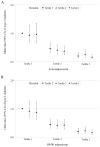Total and high-molecular-weight adiponectin and resistin in relation to the risk for type 2 diabetes in women
- PMID: 18765700
- PMCID: PMC3874083
- DOI: 10.7326/0003-4819-149-5-200809020-00005
Total and high-molecular-weight adiponectin and resistin in relation to the risk for type 2 diabetes in women
Abstract
Background: Adiponectin and resistin are recently discovered adipokines that may provide a molecular link between adiposity and type 2 diabetes.
Objective: To evaluate whether total and high-molecular-weight adiponectin and resistin are associated with future risk for type 2 diabetes, independent of obesity and other known diabetes risk factors.
Design: Prospective, nested, case-control study.
Setting: United States.
Participants: 1038 initially healthy women of the Nurses' Health Study who developed type 2 diabetes after blood sampling (1989 to 1990) through 2002 and 1136 matched control participants.
Measurements: Plasma concentrations of total and high-molecular-weight adiponectin and resistin.
Results: In multivariate models including body mass index, higher total and high-molecular-weight adiponectin levels were associated with a substantially lower risk for type 2 diabetes (odds ratio [OR] comparing the highest with the lowest quintiles, 0.17 [95% CI, 0.12 to 0.25] for total adiponectin and 0.10 [CI, 0.06 to 0.15] for high-molecular-weight adiponectin). A higher ratio of high-molecular-weight to total adiponectin was associated with a statistically significantly lower risk even after adjustment for total adiponectin (OR, 0.45 [CI, 0.31 to 0.65]). In the multivariate model without body mass index, higher resistin levels were associated with a higher risk for diabetes (OR, 1.68 [CI, 1.25 to 2.25]), but the association was no longer statistically significant after adjustment for body mass index (OR, 1.28 [CI, 0.93 to 1.76]).
Limitation: The findings apply mainly to white women and could be partly explained by residual confounding from imperfectly measured or unmeasured variables.
Conclusion: Adiponectin is strongly and inversely associated with risk for diabetes, independent of body mass index, whereas resistin is not. The ratio of high-molecular-weight to total adiponectin is related to risk for diabetes independent of total adiponectin, suggesting an important role of the relative proportion of high-molecular-weight adiponectin in diabetes pathogenesis.
Figures



References
-
- Schulze MB, Hu FB. Primary prevention of diabetes: what can be done and how much can be prevented? Annu Rev Public Health. 2005;26:445–67. - PubMed
-
- Ahima RS. Adipose tissue as an endocrine organ. Obesity (Silver Spring) 2006;14 (Suppl 5):242S–249S. - PubMed
-
- Chandran M, Phillips SA, Ciaraldi T, Henry RR. Adiponectin: more than just another fat cell hormone? Diabetes Care. 2003;26:2442–50. - PubMed
-
- McTernan PG, Kusminski CM, Kumar S. Resistin. Curr Opin Lipidol. 2006;17:170–5. - PubMed
-
- Scherer PE, Williams S, Fogliano M, Baldini G, Lodish HF. A novel serum protein similar to C1q, produced exclusively in adipocytes. J Biol Chem. 1995;270:26746–9. - PubMed
Publication types
MeSH terms
Substances
Grants and funding
LinkOut - more resources
Full Text Sources
Other Literature Sources
Medical
Molecular Biology Databases
